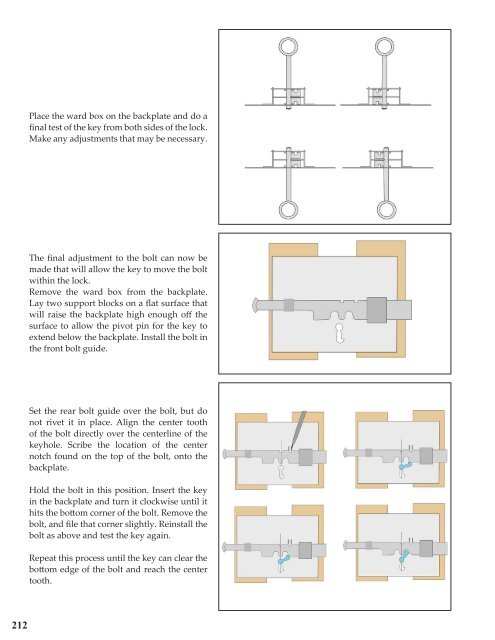The New Spruce Forge Manual of Locksmithing: A Blacksmith’s Guide to Simple Lock Mechanisms
The New Spruce Forge Manual of Locksmithing: a Blacksmith’s Guide to Simple Lock Mechanisms is a totally revised and expanded version of the original work from 1999. This new hardcover edition, at 304 pages and with more than 800 color photos and illustrations, is more than double the size of the original manual. It is divided into two distinct sections: Technical Information - This section is a reference manual in itself that covers the specific tools and techniques needed to build all the parts for each lock, as well as providing the information needed to understand the assembly instructions outlined in the second section. The Locks: Patterns & Instructions - This section provides the plans and detailed instructions for each of the 14 lock projects in this new edition. The clear assembly instructions describe when and how to use the technical information provided in section one. The authors have maintained their original trademark style that relies on well-illustrated step-by-step instructions that guide you through the whole lock-making process. They have also kept their low-tech approach that demonstrates how to go about creating good work using only a handful of simple tools. Making blacksmith locks is an age-old skill the authors of this manual are helping to preserve by passing on their knowledge to this book’s readers. The New Spruce Forge Manual of Locksmithing is also an excellent introduction to benchwork, which is a useful skill for any blacksmith to acquire. This manual will become a valuable, trusted and often referred to sourcebook in your blacksmithing library. Hardcover, 304 pages, more than 800 photos and illustrations.
The New Spruce Forge Manual of Locksmithing: a Blacksmith’s Guide to Simple Lock Mechanisms is a totally revised and expanded version of the original work from 1999. This new hardcover edition, at 304 pages and with more than 800 color photos and illustrations, is more than double the size of the original manual.
It is divided into two distinct sections:
Technical Information - This section is a reference manual in itself that covers the specific tools and techniques needed to build all the parts for each lock, as well as providing the information needed to understand the assembly instructions outlined in the second section.
The Locks: Patterns & Instructions - This section provides the plans and detailed instructions for each of the 14 lock projects in this new edition. The clear assembly instructions describe when and how to use the technical information provided in section one.
The authors have maintained their original trademark style that relies on well-illustrated step-by-step instructions that guide you through the whole lock-making process. They have also kept their low-tech approach that demonstrates how to go about creating good work using only a handful of simple tools.
Making blacksmith locks is an age-old skill the authors of this manual are helping to preserve by passing on their knowledge to this book’s readers. The New Spruce Forge Manual of Locksmithing is also an excellent introduction to benchwork, which is a useful skill for any blacksmith to acquire. This manual will become a valuable, trusted and often referred to sourcebook in your blacksmithing library.
Hardcover, 304 pages, more than 800 photos and illustrations.
You also want an ePaper? Increase the reach of your titles
YUMPU automatically turns print PDFs into web optimized ePapers that Google loves.
Place the ward box on the backplate and do a<br />
final test <strong>of</strong> the key from both sides <strong>of</strong> the lock.<br />
Make any adjustments that may be necessary.<br />
<strong>The</strong> final adjustment <strong>to</strong> the bolt can now be<br />
made that will allow the key <strong>to</strong> move the bolt<br />
within the lock.<br />
Remove the ward box from the backplate.<br />
Lay two support blocks on a flat surface that<br />
will raise the backplate high enough <strong>of</strong>f the<br />
surface <strong>to</strong> allow the pivot pin for the key <strong>to</strong><br />
extend below the backplate. Install the bolt in<br />
the front bolt guide.<br />
Set the rear bolt guide over the bolt, but do<br />
not rivet it in place. Align the center <strong>to</strong>oth<br />
<strong>of</strong> the bolt directly over the centerline <strong>of</strong> the<br />
keyhole. Scribe the location <strong>of</strong> the center<br />
notch found on the <strong>to</strong>p <strong>of</strong> the bolt, on<strong>to</strong> the<br />
backplate.<br />
Hold the bolt in this position. Insert the key<br />
in the backplate and turn it clockwise until it<br />
hits the bot<strong>to</strong>m corner <strong>of</strong> the bolt. Remove the<br />
bolt, and file that corner slightly. Reinstall the<br />
bolt as above and test the key again.<br />
Repeat this process until the key can clear the<br />
bot<strong>to</strong>m edge <strong>of</strong> the bolt and reach the center<br />
<strong>to</strong>oth.<br />
212










